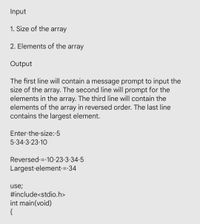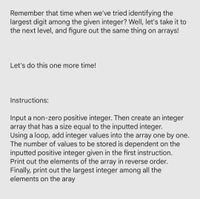
Computer Networking: A Top-Down Approach (7th Edition)
7th Edition
ISBN: 9780133594140
Author: James Kurose, Keith Ross
Publisher: PEARSON
expand_more
expand_more
format_list_bulleted
Question

Transcribed Image Text:Input
1. Size of the array
2. Elements of the array
Output
The first line will contain a message prompt to input the
size of the array. The second line will prompt for the
elements in the array. The third line will contain the
elements of the array in reversed order. The last line
contains the largest element.
Enter-the size:-5
5:34:3.23-10
Reversed = 10-23-3-34-5
Largest-element-= 34
use;
#include<stdio.h>
int main(void)
{

Transcribed Image Text:Remember that time when we've tried identifying the
largest digit among the given integer? Well, let's take it to
the next level, and figure out the same thing on arrays!
Let's do this one more time!
Instructions:
Input a non-zero positive integer. Then create an integer
array that has a size equal to the inputted integer.
Using a loop, add integer values into the array one by one.
The number of values to be stored is dependent on the
inputted positive integer given in the first instruction.
Print out the elements of the array in reverse order.
Finally, print out the largest integer among all the
elements on the aray
Expert Solution
This question has been solved!
Explore an expertly crafted, step-by-step solution for a thorough understanding of key concepts.
This is a popular solution
Trending nowThis is a popular solution!
Step by stepSolved in 2 steps with 1 images

Knowledge Booster
Similar questions
- Create Array of Random Dates In this task you are required to write a function that will generate a column array (a variable called dates) containing N random dates. N is an integer (whole number) entered by the user and will indicate to the function how many random dates the user requires. The dates array will be structured as follows: • The array shall have two columns; column 1 will contain numbers indicating the day of each month (1-31) and column 2 will contain numbers indicating the month (Jan 1, Feb=2, Mar = 3.... Dec = 12). . Each day must be randomly generated (using the randi() function) taking into account the maximum number of days in each month (i.e. Jan, Mar, May, Jul, Aug. Oct and Dec have 31 days, Apr. Jun, Sep and Nov have 30 days and Feb will have 28 days). You must use an if-elseif-else statement to decide this. • We are assuming no leap years (e. February can only have days between 1-28). For example, the output from calling the function: output = dategen (3) could…arrow_forwardPlease written by computer source (java)arrow_forwardIn visual basic Create an array that will hold 10 integer values.arrow_forward
- Weight Statistics Write a program that monitors monthly weight loss each of 12 months into an array of doubles. The program should calculate and display the total weight loss for the year, the average monthly weight loss, and the months with the highest and lowest amounts. Input Validation: Do not accept negative numbers for monthly weight loss.arrow_forwardAlphabet Random Walk• Write a program to generate a random walk that spans a 10*10 character array (The initial values of the elements are all.). The program must randomly walk from one element to another, moving one element position up, down, left or right each time. The elements that have been visited are labeled with the letters A through Z in the order in which they were visitedarrow_forwardVisual basic 6.0arrow_forward
- part a- 2point) for 3 students find the average of a student by asking him how many grades do you have. The answer to this question, determine the size of the array(list of grades) and then ask the user to enter grades(the number of the grades is equal to the size of the array) then calculate the average for each student. Hence, you will calculate 3 averages. to calculate the average, use the array accumulator. Also when you get each grade validate it. validation for grade means that you check whether a grade is between 0 and 100. if the grade is negative or a grade is more than 100 then it is not valid and you have to ask the user to enter a grade again. Part b- 1 point) Find the maximum and minimum grades for each student. Part c- 1 point) Print the sorted list of the grades for each student. example: if grades user entered are: 60 78 98 23 45 then sorted list is:23 45 60 78 98 (Array not vector)arrow_forwardWrite a function to determine the resultant force vector R of the two forces F₁ and F2 applied to the bracket, where 0₁ and 0₂. Write R in terms of unit vector along the x and y axis. R must be a vector, for example R = [Rx, Ry]. The coordinate system is shown in the figure below: F₁ y 0₂ 0₁ 1 ►x F2arrow_forwardFYI: Please write the code in Pseudocode (no programming language please) 1. Write a pseudocode that outputs the contents of parallel arrays. You do NOT have to write the entire program. The first array will hold phone numbers The second array will hold company names You do NOT need to load the arrays. Your code can assume they are already loaded with data. arrays are named phone[] and company[]arrow_forward
arrow_back_ios
SEE MORE QUESTIONS
arrow_forward_ios
Recommended textbooks for you
 Computer Networking: A Top-Down Approach (7th Edi...Computer EngineeringISBN:9780133594140Author:James Kurose, Keith RossPublisher:PEARSON
Computer Networking: A Top-Down Approach (7th Edi...Computer EngineeringISBN:9780133594140Author:James Kurose, Keith RossPublisher:PEARSON Computer Organization and Design MIPS Edition, Fi...Computer EngineeringISBN:9780124077263Author:David A. Patterson, John L. HennessyPublisher:Elsevier Science
Computer Organization and Design MIPS Edition, Fi...Computer EngineeringISBN:9780124077263Author:David A. Patterson, John L. HennessyPublisher:Elsevier Science Network+ Guide to Networks (MindTap Course List)Computer EngineeringISBN:9781337569330Author:Jill West, Tamara Dean, Jean AndrewsPublisher:Cengage Learning
Network+ Guide to Networks (MindTap Course List)Computer EngineeringISBN:9781337569330Author:Jill West, Tamara Dean, Jean AndrewsPublisher:Cengage Learning Concepts of Database ManagementComputer EngineeringISBN:9781337093422Author:Joy L. Starks, Philip J. Pratt, Mary Z. LastPublisher:Cengage Learning
Concepts of Database ManagementComputer EngineeringISBN:9781337093422Author:Joy L. Starks, Philip J. Pratt, Mary Z. LastPublisher:Cengage Learning Prelude to ProgrammingComputer EngineeringISBN:9780133750423Author:VENIT, StewartPublisher:Pearson Education
Prelude to ProgrammingComputer EngineeringISBN:9780133750423Author:VENIT, StewartPublisher:Pearson Education Sc Business Data Communications and Networking, T...Computer EngineeringISBN:9781119368830Author:FITZGERALDPublisher:WILEY
Sc Business Data Communications and Networking, T...Computer EngineeringISBN:9781119368830Author:FITZGERALDPublisher:WILEY

Computer Networking: A Top-Down Approach (7th Edi...
Computer Engineering
ISBN:9780133594140
Author:James Kurose, Keith Ross
Publisher:PEARSON

Computer Organization and Design MIPS Edition, Fi...
Computer Engineering
ISBN:9780124077263
Author:David A. Patterson, John L. Hennessy
Publisher:Elsevier Science

Network+ Guide to Networks (MindTap Course List)
Computer Engineering
ISBN:9781337569330
Author:Jill West, Tamara Dean, Jean Andrews
Publisher:Cengage Learning

Concepts of Database Management
Computer Engineering
ISBN:9781337093422
Author:Joy L. Starks, Philip J. Pratt, Mary Z. Last
Publisher:Cengage Learning

Prelude to Programming
Computer Engineering
ISBN:9780133750423
Author:VENIT, Stewart
Publisher:Pearson Education

Sc Business Data Communications and Networking, T...
Computer Engineering
ISBN:9781119368830
Author:FITZGERALD
Publisher:WILEY